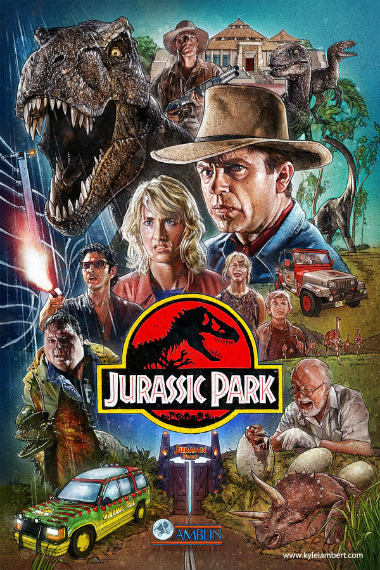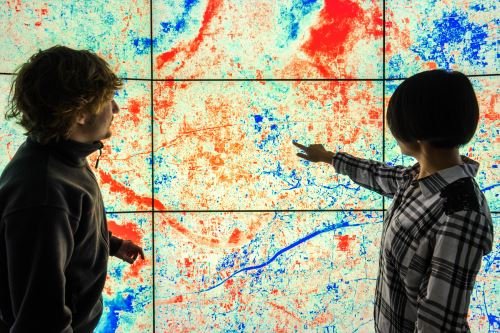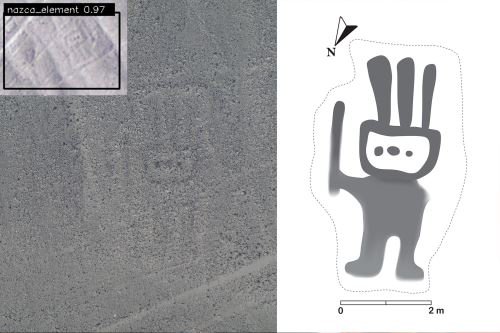Recently I was reviewing news about the applications of technologies associated with AI in the fields of Health Sciences, Market Research and other things like that, I found a piece of news that stood out because it was not a field that I had noticed a lot lately: The one of the Archaeological Investigations.
First a comment on personal memories :)
To a large extent it was my turn to smile a little and think that archeology, from its birth, is known as a discipline that uses other disciplines and sciences very widely as auxiliaries for the achievement of its own investigations. But I also remembered a less serious subject, but also pertinent, you see, I am very inclined to remember things by images and cinematic memories, in this chaos a movie I saw in my youth came to mind: Jurassic Park (1993 )

Source
In it, a somewhat eccentric millionaire created a park of living attractions by bringing extinct specimens of dinosaurs back to life. This man also sponsored archaeological projects and excavations of biological materials preserved in Amber, all this linked to the creation of the amusement park.
To get the support of the board of directors of his corporation, he needed the evaluation of experts and sought a couple of archaeologists whom he had been financing. It's just those scenes that came to mind, The group is working in the field, but instead of digging everything around it, the main group was detonating shallow charges and using a very sensitive seismograph to be able to make a Profile of the subsoil, showing the location and arrangement of the fossils, the technician who operated the team commented that in the future it would not be necessary to even dig.
At the time, I thought that in the future, archaeological remains could be better preserved if they were able to study without extracting them and then identical models were created for later display. Well, today these things are done, there is also the use of virtual reality for the recreation of the ruins and also virtual visits, which turns out to be a good thing, because tourism can affect the ruins more than we would believe.
Come on now with the central theme
Well, the news I saw was several, in different places (all in Spanish), but in general they were the same news:
- Andina - Agencia Peruana de Noticias: Así se utilizó inteligencia artificial para descubrir nuevos geoglifos en Nasca
- IA Latam - Así se utilizó inteligencia artificial para descubrir nuevos geoglifos en Nasca
- El País - La inteligencia artificial ayuda a descubrir 142 nuevos geoglifos en Nazca
The news was under the signature of Harold Moreno Luna.
In a way of summary, what was reported was that 143 new geoglyphs were discovered in the territory of the Pampas of Nasca thanks to a study by the University of Yamagata (Japan) applying IBM artificial intelligence (AI) technology. Akihisa Sakurai, an IBM engineer and member of the IBM Academy of Technology (IBM Research - Tokyo), stated:
“It is the same hardware technology behind the world's most powerful supercomputers, such as the Summit of the United States Department of Energy (which, since June 2018, is considered the fastest in the world, with a speed of 200 billion billions. of operations per second) or Sierra (of the National Nuclear Safety Administration, with a speed of 125 billion operations per second), ”he said.
Sakurai explained that they used Deep Learning or deep learning algorithms to detect figures on the ground. This technique uses several layers of information analysis, in which the ‘output’ information of one is the same as that of ‘input’ of another, allowing complex analysis and pattern recognition.
“Learning emulates the structure of the brain with neural networks implemented between‘ input ’and‘ output ’(information) of the Deep Learning model. By repeating this process several times, neural networks learn how they should connect to each other, based on learning parameters such as the lines that are part of the geoglyphs, ”he added. (Translated by my account)
The images captured by satellites, drones, aircraft and others were used to then confront any anomaly of the images and ensure that the system learned to differentiate the geographical accidents that had a human cause, that is, unnatural alterations of the anthropogenic type.
The use of this technology demonstrated its usefulness by making dozens of new discoveries and giving information that was not available, thanks to the analysis and its subsequent verification in the field, the efficiency of the procedure could be evidenced and progress was made in the knowledge of this set of lines that make up the Nazca Lines, although we are still far from understanding the real meaning or meaning that this heritage of humanity has.
It's a good thing, but ...
Well, those who already know me, know of my tendency to be interested in technologies, but always keep in mind that one of the first fields of application of these are military and arms fields in general. So what could worry me about this news that is so academic?
The answer is simple, the AI system learns to interpret objects or landforms from a means to differentiate those that are created by humans from those that are due to natural causes. I see it as obvious that if I place this AI in a satellite surveillance system, it could have a significant advantage in a war field where each side tries to hide its positions and the movements of its forces.
But also, if you load the AI into a missile system and shoot them with the prerogative of modifying their targets if the information obtained on the ground flight allows them to identify a higher priority target than the one set at the time of launch.
All this and more are things that are already already under test or even already being implemented in the field, after all, I am used to the fact that every technology that reaches the civil world has been known and used by the military world for many years of advantage.
Post published for the @project.hope community - https://beta.steemit.com/created/hive-175254
20% of this Post is intended to support @project.hope - Project #HOPE Community

Project #HOPE Website


Hi! I didn't know you could use AI to look for archaeological remains. That's fascinating. Outside of the obvious, your concern that this technology is actually used to monitor other nations and find vulnerabilities in the event of war, could be real..
But, don't you think it's interesting that the Japanese are curious about Peru? I have always thought that Peruvians have Asian roots, probably because there is a connection between both countries. Maybe, even there is a real connection, there are books that say that there are caves that could connect us to the other side of the world.
That makes me think.
Thanks for sharing :D
Downvoting a post can decrease pending rewards and make it less visible. Common reasons:
Submit
In the case of Japan and Peru the interest is of old data, I believe that there are archaeological works that linked Jomón ceramics from South America are a ceramic style of South Asia, in addition to the fact that a theory that migration to American continent went by waves and one of those waves went from Asia to South America, so there are also genetic markers in the aboriginal population that confirms this, also the external physical appearance gave this idea before, but with the study of genes it was confirmed what That was suspected.
Downvoting a post can decrease pending rewards and make it less visible. Common reasons:
Submit
I didn't know that.
Downvoting a post can decrease pending rewards and make it less visible. Common reasons:
Submit
:)
There was a time when I had to review the methodology of a research project of a colleague at the University where anthropologists and archaeologists would work on an issue of ancestral migrations and I remember some of the things I reviewed in that work.
Downvoting a post can decrease pending rewards and make it less visible. Common reasons:
Submit
Interesante :D
Downvoting a post can decrease pending rewards and make it less visible. Common reasons:
Submit
Si. Las aplicaciones son interesantes y me pregunto un tanto qué será en el futuro esta disciplina de la Arqueología con el uso de otras nuevas tecnologías. Quien sabe,puede que los futuros "Indiana Jones" sean II.AA.
Downvoting a post can decrease pending rewards and make it less visible. Common reasons:
Submit
I suspect that the biggest challenge would be getting the right amount and the right quality of data to adequately train your systems, and then (as I currently understand the topic), you would still be only able to detect that for which the system was trained. But the tech is already much more mature than I would have expected even just a few years ago and with the new specialized processors coming out each year, we will probably exceed even your expectations sooner than we think!
Downvoting a post can decrease pending rewards and make it less visible. Common reasons:
Submit
I share the optimism :)
Downvoting a post can decrease pending rewards and make it less visible. Common reasons:
Submit